I set out to backpack the 22-mile southern loop of the Linville Gorge the first weekend in November of 2018. Not only was it peak colors, but the fact that it was November meant that I didn’t have to worry about getting an overnight permit (April–October only). I got to the Wolfpit Pass Trailhead at 9:30 am and started hiking to the summit of Shortoff Mountain. I decided to hike the loop counterclockwise so that I would knock out the harder half first.
My goal was to hike around 17 miles on the first day and then make the final 5-mile climb out of the gorge and back to my car the next morning. Then I planned to visit a couple of nearby waterfalls and complete my trip with some pizza and beer at Lost Province Brewing in Boone before heading home. That would make for a nice little weekend trip.
The hike
I was up to the summit of Shortoff in no time. It was windy and around 40°, so I wasn’t sweating. I felt so good that I didn’t even need to top off my water bottles at the pipe spring. I love walking ledges and ridgelines, so I made short work of the rim and even the strenuous climb through the saddle and up to The Chimneys—the craggy cliffs that attract rock climbers and day hikers to the area.
I passed the crowded parking lot near the Table Rock Trail and started heading down the mountain toward the Linville River. I was making great time, having cranked out about 10 strenuous miles in a little over 4 hours. As I approached the river, I passed a few groups of backpackers who had retreated because they deemed the river uncrossable. The bridge at the Spence Trail crossing has been out for years and the water is deep in some places. If you don’t swim across fast enough, the current will catch you and pull you into the sluices. That’s a recipe for disaster.
I finally popped out at the river and made my way across the remains of the bridge to the water’s edge, where large boulders serve as boundaries instead of shoreline.
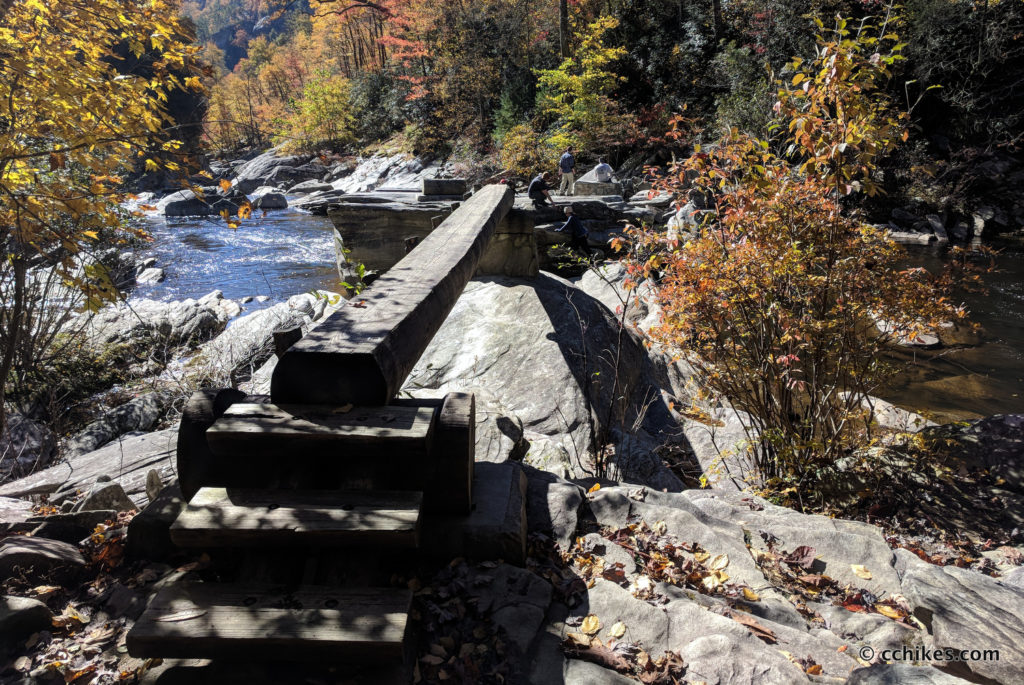
In some places, the gap between shoreline boulders is fairly narrow. If the boulders were flat, one could easily jump across. But the boulders are steep and slanted. Failing to find good footing would result in a dip into whitewater where it’s rushing the fastest.

When people ask me about backpacking alone in the wilderness, they’re preoccupied with beasts. They think the biggest threats are bears, wolves, and crazy people. The only things that have ever scared me in the wild are the threats of whitewater and hypothermia. In retrospect, I should have stripped down to just my underwear and shoes and jumped in and swam across. But hindsight is 20:20.
The leg break
There were a handful of people sitting around on the boulders admiring the view of the river. I asked if any of them planned to cross and they all confirmed that they were day hikers enjoying the sunshine by the water. I asked if they would throw me my pack if I reached the other side and they agreed. Then I dropped my pack, grabbed my hiking poles, and probed every possible way across that didn’t involve swimming. The groups before me had gotten into my head and I really wanted to avoid the water.
I finally decided that a jump from one boulder near the bridge footing to another near the trail on the other bank was my best bet. The distance wasn’t too bad; the worry was that the boulder was slanted upward like a deformed pyramid. But I figured that incline would help me to arrest my fall as I landed and grabbed on with my arms.
I packed everything tightly into my pack and left it with the lookers-on. I carefully measured my steps and prepared to jump. It was around 2:00 pm. I made the leap with my left foot and landed with my right. I landed about a foot above the waterline and reached for the rock with my hands. I caught myself rather deftly and was relieved that I managed to keep from sliding back into the water. I made to crawl up to the relatively flat top of the boulder so I could straddle it and brace myself to catch my pack. That’s when I knew something was wrong.
My left foot didn’t work. I had no control over it. It dangled at the end of my leg like a yo-yo on a string. Once I saw the bulge sticking out above my inside ankle, I felt the pain. It all happened at once. I remember muttering, “I broke my leg,” as I looked back at the people on the opposing boulder. They had their hands over their mouths. We all immediately recognized how bad the situation was.
I slowly pulled myself to the top of the boulder with my hands, dragging my injured leg. It was trailing blood. I motioned to the people standing opposite the river to get their attention. It was challenging to hear each other over the roar of the water. I told them to open my pack and pull out my waterproof ditty bag where I kept my first-aid kit. I had them open the bag and put two bandanas from my pack inside. Then they rolled the top and clipped it closed. I told them to toss it to me so I could dress the wound.
They had some cord on hand and wisely tied one end to the bag in case I failed to catch it. That way, they could reel it in and we could try again. Thanks to a good toss, I caught it on the first attempt. I pulled up my gaiter and lowered my sock to reveal my tibia peeking out of my skin. I tied the bandana just above the breach and pulled it as hard as I could. The bone retreated and my head fell backward in silent, teeth-clenched horror.
Next, I retrieved my small tube of blood clotting powder and sprinkled it over the wound. It fizzed like Pop Rocks and the bleeding slowed. I pulled my sock back up over the wound and covered it again with my gaiter. I had no desire to look at the wound again. Next, I rolled up the other bandana and tied it just below my knee as a tourniquet. Finally, I assessed the situation.
I was worried that I might pass out from the pain or simply slide off the boulder into the river. I yelled for the observers to open my pack again and showed them where my ID, insurance card, and credit card were located. They asked me about allergies to medications and all of the things that get bantered about in emergency situations. Before I had to ask, someone volunteered to run to the top of the mountain to find a cell signal and call 911. I remember asking him to see if there was any way to get a helicopter.
In my mind at the time, all I could think was that of everywhere I had been in the gorge (aside from the canyon rim), this was the most wide-open place to find and help an injured person. In a sea of green canopy, I just happened to find myself on a gray dot in a ribbon of pale blue. The heavens would open up, a golden rope would descend, and I would be saved. It was not to be.
The number of observers grew. People were coming from all around to look at the guy bleeding all over the rock in the middle of the rushing water. Everyone was wondering what to do. I was wondering the same.
I and everyone else around me tried to keep it light. I made jokes about my conundrum. They made jokes about waiting until I fell into the water and running off with my credit card. I told them it wasn’t worth the effort.
Finally, someone convinced me that I’d have to walk out for two reasons. First, no helicopter was going to come. It would be people on foot that got me out, and we already had people on-site to do just that. It didn’t make sense to wait. Second, I had at least one severed bone that was exposed to the environment. Every minute that went by increased my risk of infection that could claim my foot at best, and my life at worst.
Internally, I had already come to terms with losing my foot. I figured it would take many hours to get out, and that was only if the river didn’t take me first. I remember thinking to myself, “if I can just keep my knee, I can still do everything with a prosthetic that I can do with my foot.” That’s a sobering thought in retrospect.
Despite the blood clotting powder, my leg kept trickling blood like a leaky pipe. I eventually used my water bottle to wash away the crimson pool that had accumulated in a depression in the boulder. I didn’t like the visceral reminder that the clock was ticking.
The rescue
After about an hour on the boulder, we came up with a plan. Two guys stripped down and swam across the river and let the current lead them to my boulder. Seeing how easy this was made me curse not simply swimming across in the first place.
At the rock, we put the plan into action. I slowly slid down into the water. The pain in my leg was excruciating. I thought the cold water might provide some relief, but the jostling of my ankle joint in the water was a constant reminder of my dilemma. We set ourselves adrift feet-first and they flanked me on each side as we let the current pull us into the rushing water. I remember hearing the onlookers scream, “keep your feet high in the water!” Getting caught on underwater impediments is a common way to drown.
As soon as we slipped through the small sluice, they swam toward the shore and I turned my body so I floated head-first. I held my broken leg with my left hand and swam with my right. I could eventually touch the bottom with my right foot and worked my way toward the rocks. I stabbed at the ground with my left leg and each push confirmed that this leg was effectively worthless.
Several people had gathered on the craggy shoreline and a couple of them grabbed my right arm and hauled me in as I labored to stand on my right leg. They got me upright on the slippery rocks and held me in place. It was then that I realized I had either severely sprained or broken my right foot as well. But seeing as I couldn’t use my left foot at all, I figured I could deal with the pain and used my right leg like a very painful pogo stick.
It took a while, but we eventually made our way from the slippery shoreline to the dry area where the old bridge used to be.
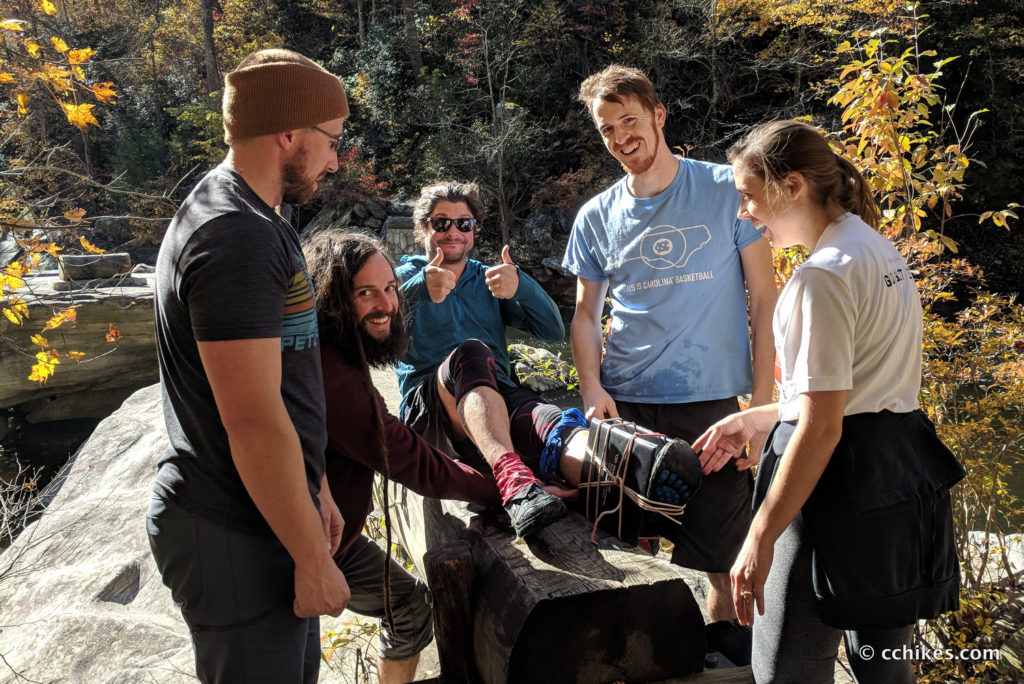
As luck would have it, one of my water guides was an Emergency Room nurse (the guy in the blue shirt) who was also training to be a Physician’s Assistant. He took a look at my injury and explained that he could probably fashion a makeshift splint. I had tried to splint it with the bottom third of my trekking pole while on the boulder, but there’s just not enough grip on the pole shaft to make anything rigid.
He had a small medical binder in his day pack. He borrowed a knife from one person and some rope from another person and was able to craft a box splint that would at least keep my foot from dangling left to right. I lay on the old bridge footboard as they tied me up. I changed into a dry shirt while people force-fed me grapes to keep my blood sugar up.
The 911 caller had not returned down the mountain, but we knew that even if help was coming, I stood a better chance of making it out if we met them on the way down than if we waited just to take the same route up later. There were six guys and four girls. It was decided that I would drape my arms around two guys’ shoulders and they would alternate helping me hop me up the mountain. The girls would carry the packs, including mine.
After mere yards, it was obvious that my effort was more of a hindrance than a help. So we amended the plan so that one person would walk in front, holding my legs against his hips. That person would carry most of the weight and the guys would rotate out to conserve energy. We started up the mountain.
The going was slow. I felt every step in my left leg as my calf and foot bounced up and down, but I never complained. I tried to keep it light, sometimes making them laugh to the point that they warned they might drop me. I remember saying, “don’t worry about dropping me, I’m already headed to the hospital.”
Later, the nurse apologized for touching my butt. I told him, “you can shove your fingers up my ass if it’ll help you get me up this mountain.” We had to stop when everyone started laughing again. It was arduous and perilous at times as the trail narrowed and the person on the cliff edge came close to falling.
We took many breaks. Every time we stopped, I imagined crawling on my hands and knees in absolute agony. That would have been my fate if these generous and courageous strangers hadn’t been around and volunteered to help.
I thanked them profusely and apologized repeatedly for “commandeering your Saturday off work.”
I thought that I might get numb to the pain, but that never happened. I got nauseous instead. I focused on fighting that nausea and maintaining my composure. We had to stop a couple of times just for me. Not because of the pain, but because I had so little blood in my hands that my fingers curled into my palms and I couldn’t uncurl them without lowering my arms and letting the blood flow. It was a long, hard slog.
The professionals
We passed a few groups of hikers, most of whom offered to help by rotating in. Others merely stared at my leg dripping blood on the forest leaves. We finally heard a voice that said, “is that my guy?” It was the EMT. He was the head of a team that was at the trailhead. They were waiting for an ambulance and for two 4-wheel ATVs to arrive to pick me up from that point and drive me the rest of the way.
My saviors laid me down on the trail and caught their breath. Despite help arriving, no one left. The EMT laid out his bag and started cutting away the splint and the tourniquets and the gaiters and shoelaces. He eventually got to the skin and took a look at the situation.
He immediately set up an IV and started me on a saline drip to alleviate my dehydration. Then came the antibiotics to fight infection. Finally, I received pain reliever (Dilaudid). I don’t remember feeling less pain. I only remember feeling like my eyelids were being forced closed and I had to fight to keep them open.
He cleaned the wound with iodine and set himself to making a proper splint to hold my foot stable for the rest of the trip. I remember him laying everything out. He looked at me and said, dourly, “there’s no way to sugarcoat it; this is gonna hurt real bad.”
I thought the anticipation of the pain would be worse than the pain itself. It wasn’t. People, mostly the girls, gathered around my shoulders and pressed me down with gentle, reassuring hands. I remember pulling my tongue inside my mouth so I wouldn’t bite it. Despite everything that had happened and was happening, I was still worried about embarrassing myself.
The EMT pressed the firm, orange foam against the bottom of my left foot. He pressed my foot up into a fixed position and folded the material over my toes and around my Achilles tendon. This was very painful. Then he took another piece of foam and wrapped it tightly around my ankle, pressing the bone back into its original position and cantilevering my foot even higher. This was absolutely excruciating. I remember shaking so badly that I couldn’t have made a sound if I wanted to. Finally, he wrapped everything in a bandage and secured it tight.
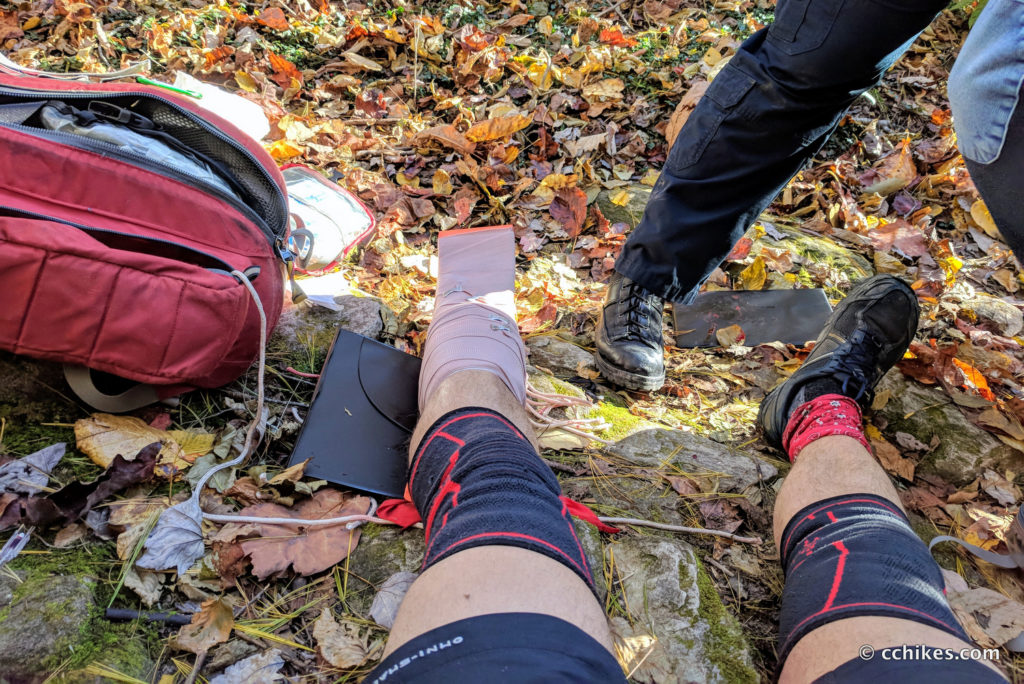
At this point, everyone said their goodbyes, but not before I made a video of most people telling me their names and email addresses so I could thank them properly later.
Here’s that video sped up with no audio so I don’t share their personal details with the world. I just thought you might like to see the faces of the people who came together to help someone they’d never met before. The couple on the right was visiting the U.S.A. from Turkey and sacrificed hours of their limited time just for me. It’s very humbling.
In an act that went beyond kindness, a couple offered to get my car at the other end of the gorge and shuttle it to the hospital. This was the only moment in my ordeal that I came close to crying. It was so completely selfless and unexpected. I had already cost them their day, and now they were freely giving me their night. They even visited me later in the ER with some very kind words that still warm my heart.
It had been about three hours since my accident and I thought I was out of the woods (pun intended). We were still in the valley, so the sun would set early. I was injured with blood loss and in wet clothes. The head EMT asked me, “do you have cold weather clothing?” I replied, “I did until I sent those two with my pack to get my car.” We both chuckled.
To add insult to injury, the tendons behind my left knee started cramping. The tendon was so tight that I had visions of those packing envelopes where you pull the string through the top of the package to rip the opening. The stress was painful enough that I worried the fleshy cord might split my skin in a bid to find the path of least resistance. There was nothing I could do but grind my teeth in frustration. The EMT said it was from dehydration, but he wouldn’t give me any water because I was likely headed for surgery. He was right, that glorious bastard.
A few more EMTs had arrived on foot and we were negotiating ways for them to carry me to the ambulance when the ATVs finally arrived. I had envisioned a rescue similar to that of a ski patrol medic pulling a sled-bound person down freshly groomed snow to safety. Instead, I rode bitch on the back of the ATV with my bandaged leg sticking out like the bright orange target on a dunking booth. I decided that I could take the pain as long as I got the hell out of the woods.
The head EMT fired up the ignition and off we went. The thing about negotiating rocks and roots on a trail meant for foot travel is that there’s no negotiating at all. If there’s an impediment, you gun it. If there’s a slippery curve, you gun it. If there’s any chance you might lose control, you gun it. My limp foot fluttered like a team flag in a car window on the way to the big game. I thought it might shimmy right off the end of my leg.
I was all over the ATV. There were times when I almost fell out and times that I swore we were going to backflip. But we eventually made it to the parking lot where I was transferred to a smooth-rolling gurney and eventually into an ambulance.

The pain that I endured on the back of that ATV provided me with me an entirely new scale of agony. It’s hard to explain. With this new perspective, I felt foolish for ever having complained about so many mundane things in my life. Nothing that happened next—not the surgery, not the aftermath, and not the recovery—would even come close to that kind of torture.
The ambulance ride was probably about 90 minutes and mostly featured a rollicking ride down a gravel mountain road. The EMT kept apologizing for the bumpiness, but I didn’t really care. I was laying on a bed with my leg in a secure brace. Painkillers were flowing into my bloodstream and I was on the way to a hospital somewhere in small-town North Carolina. Having endured the injury, the swim, the climb, the splinting, and the ATV ride, everything looked rosy by comparison. I kept repeating to myself, “if I can just keep my knee…”
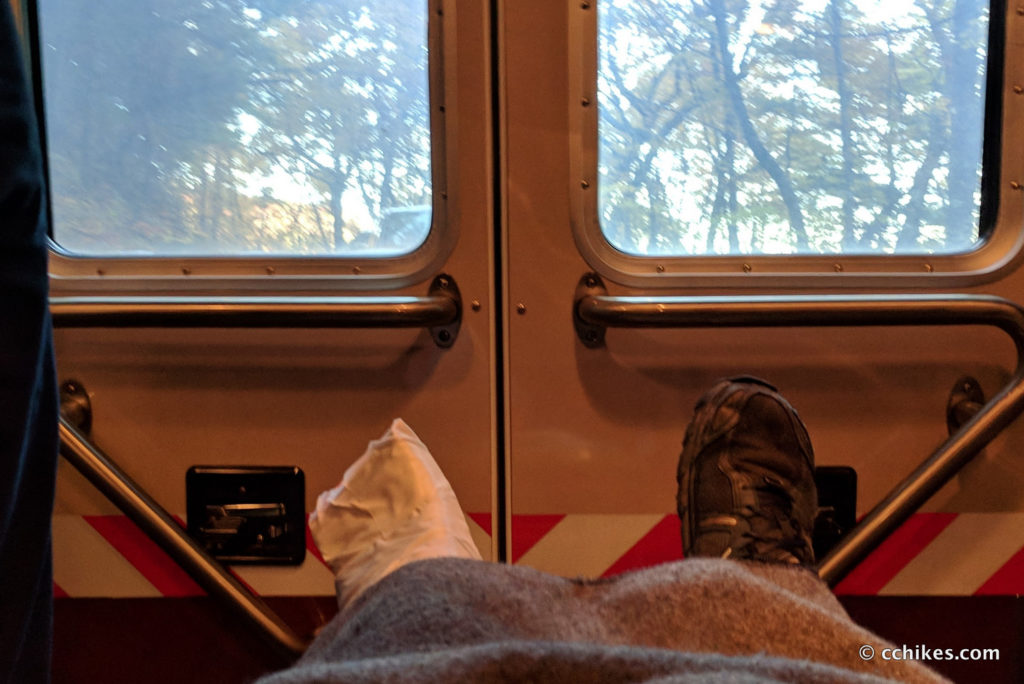
The hospital
I’m not going to go into a lot of detail here. There was a question of whether I would be able to get proper help at this hospital or whether I’d be driven to Asheville or Charlotte. It just so happened that the area’s foremost Orthopedic Surgeon, who also just so happens to specialize in ankles and wrists, was available for surgery that night. So I was sent for X-rays and prepped for surgery.
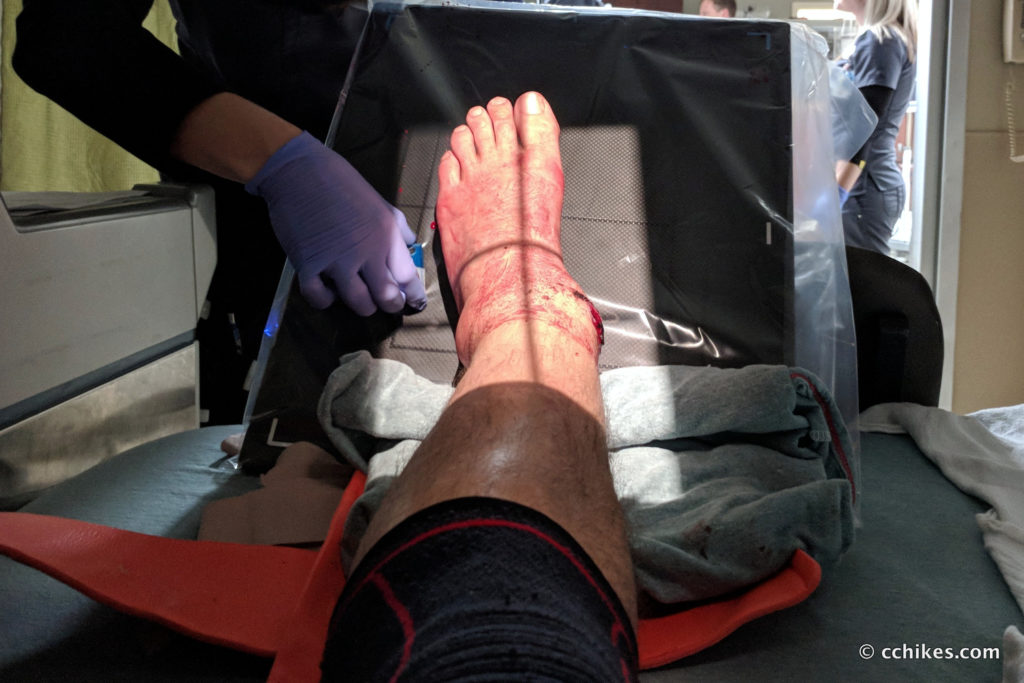
This is when I got my first look at my bones. I snapped my tibia and fibula clean in half. The team X-rayed my right foot too and I was pleased to see no breaks. It was only badly sprained. That would keep me out of a wheelchair and for that I was grateful.
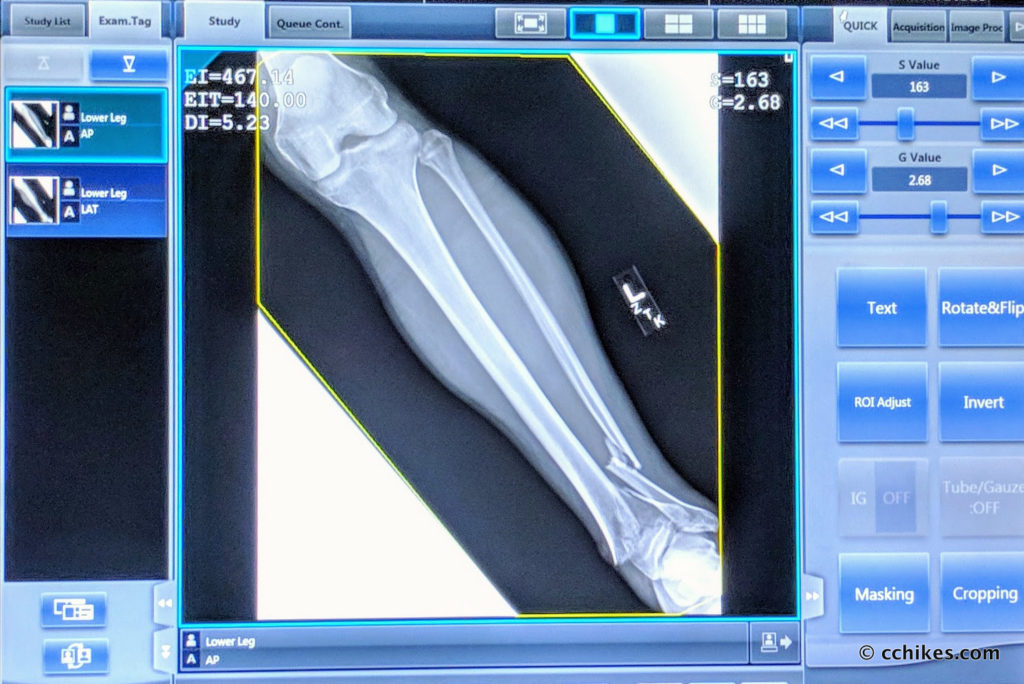
The surgery started at 9:30 pm, a full 7½ hours after the accident. The procedure lasted until around 11:00 pm. I woke up sometime before midnight.
I was in a different kind of pain. It was a dull, consistent, aching pain—pain that gave new meaning to the cliché, bone-chilling. It was absolutely unwavering, even if it wasn’t as acute as the pain from earlier in the day. I didn’t mind it much compared to the climb out of the river and the ATV ride, but it was my new, non-stop normal.
I always assumed that if everything hurt everywhere, then nothing would hurt in particular. That’s not true. Everything hurts in particular everywhere and your brain plays a manic game of whack-a-mole, racing from one stimulus to the next trying to find focus. It’s mentally and physically draining.
The fixation
The doctor had installed a device called an external fixation. My leg bones were free-floating. There was no way for them to reattach unless my ankle remained stationary for some time. This device performs that task, but at great discomfort. I couldn’t get a good look at it since it was buried under bandages until the end of my hospitalization.
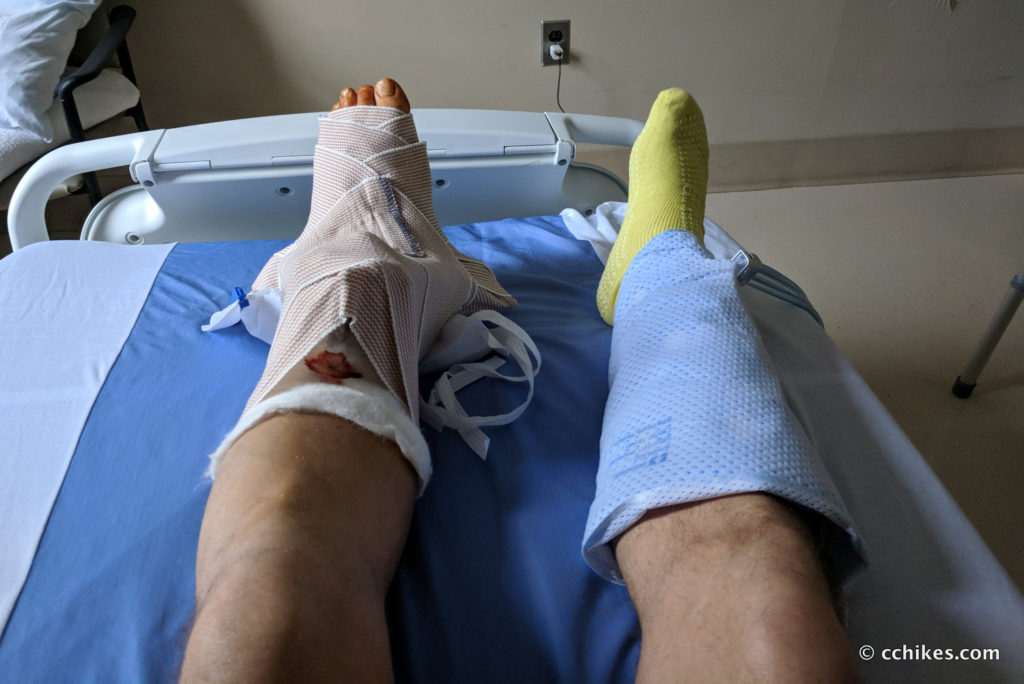
I hoped to be released after the procedure, but my fever, elevated blood pressure, and heightened risk of infection kept me there for two more days.
I was in constant pain. Because of the shape of the fixation, I had no choice but to lay on my back. My left foot could only point straight up. And since the fixation included a bar that went straight through my heel, that meant the weight of my leg constantly pressed down on the freshly drilled hole in my heel. I could feel the bar. It was unignorable.
The bar in my heel was the base of a triangle that joined at my shin where two screws were drilled directly into that bone. Any effort to ease the discomfort on my heel—like putting a pillow under my calf—would result in upward pressure on my shin bone. There was no relief. Ever. I had to pick which position sounded less torturous from moment to moment and adjust accordingly.
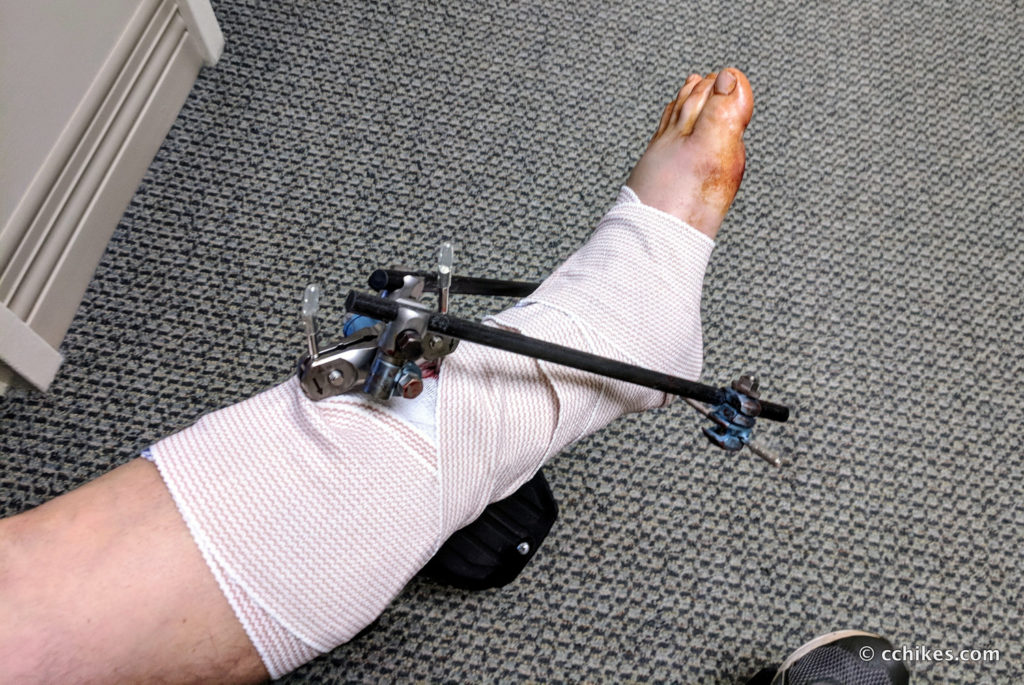
Imagine being placed in a box that’s too small for your body. You can either bend your knees and stretch your back, or bend your back and stretch your legs, but never both. It’s kind of like that. Except you have screws and rods in your bones and everything hurts everywhere all the time. As your foot and leg swell, your ankle bones pop in and out of socket. Your bones shift unnaturally and knock against each other. The feeling is so alien and offensive that the brain processes it as panic. It’s hard to overcome sometimes. You just want to scream.
One thing I find interesting is the fact that getting sutures is usually an ordeal in its own right. But considering everything else that was going on, sealing up the hole where my tibia popped out was just an afterthought. You can see it at the link below.
WARNING: The following photo is pretty graphic, so you have to click on it to open it in a new window. If you don’t like seeing trauma, scroll down. Click here to see a photo of my foot without the bandage.
The recovery
I’m finally home and on my 6th day with the fixation in my leg. Despite the medications, the pain is terrible and relentless. I can never sleep for long without being jerked awake in pain. I’ve been put on sleeping pills that manage to allow me to rest for up to three hours sometimes. But the same things happen; the discomfort reaches a tipping point and I wake up; I reflexively try to change sleeping positions and my bones grind, causing me to moan as I awaken; or my foot simply spasms to the side on its own and I’m slapped awake in agony. There is no reprieve.
As bad as the pain is, there’s something almost as bad that everyone overlooks—the boredom. I have to keep my leg elevated, so I live on the couch. I’m awake at all hours of the day but I have nothing to do. I can barely walk behind a walker like an old man. My right foot is just now returning to full flexibility, even if it still bears the pain of a sprain. Moving is an exhausting chore.
As someone who is very active both outside and inside of the home, it’s crushing to become fully dependent. I know there’s a beginning and a middle and an end to this. And I feel grateful that instead of being fitted for a prosthetic, my biggest worry is likely joint pain in my ankle in the future.
There’s a long road ahead of me. The fixation will eventually come out and then I’ll wear a cast for a couple of months and a boot for another one. I only hope I manage to cross the distance with grace and humility and not get bogged down by the fact that others made the same leap as me and paid no price.
I try to focus on how many factors played into my story. The fact that the area where my injury occurred is usually desolate. I’m fortunate that I happened to be there when there were people around. I’m grateful that the people around me were not only willing to put themselves in harm’s way to help me, but also that they brought skills to the table that were essential in my successful retreat. And I’m thankful to be surrounded by people in my life that have stepped away from their own duties to provide help to me when I need it most.
I hope that whenever anyone around me needs help, I have the wisdom to recognize it and the willingness to provide it. I have a new perspective on the fragility and ephemerality of life, and I plan to hold onto it as long as I’m able. But that doesn’t mean I’m done with hiking.
I go on a backpacking trip at the end of every summer. That timeline should work nicely with my recovery. I think.




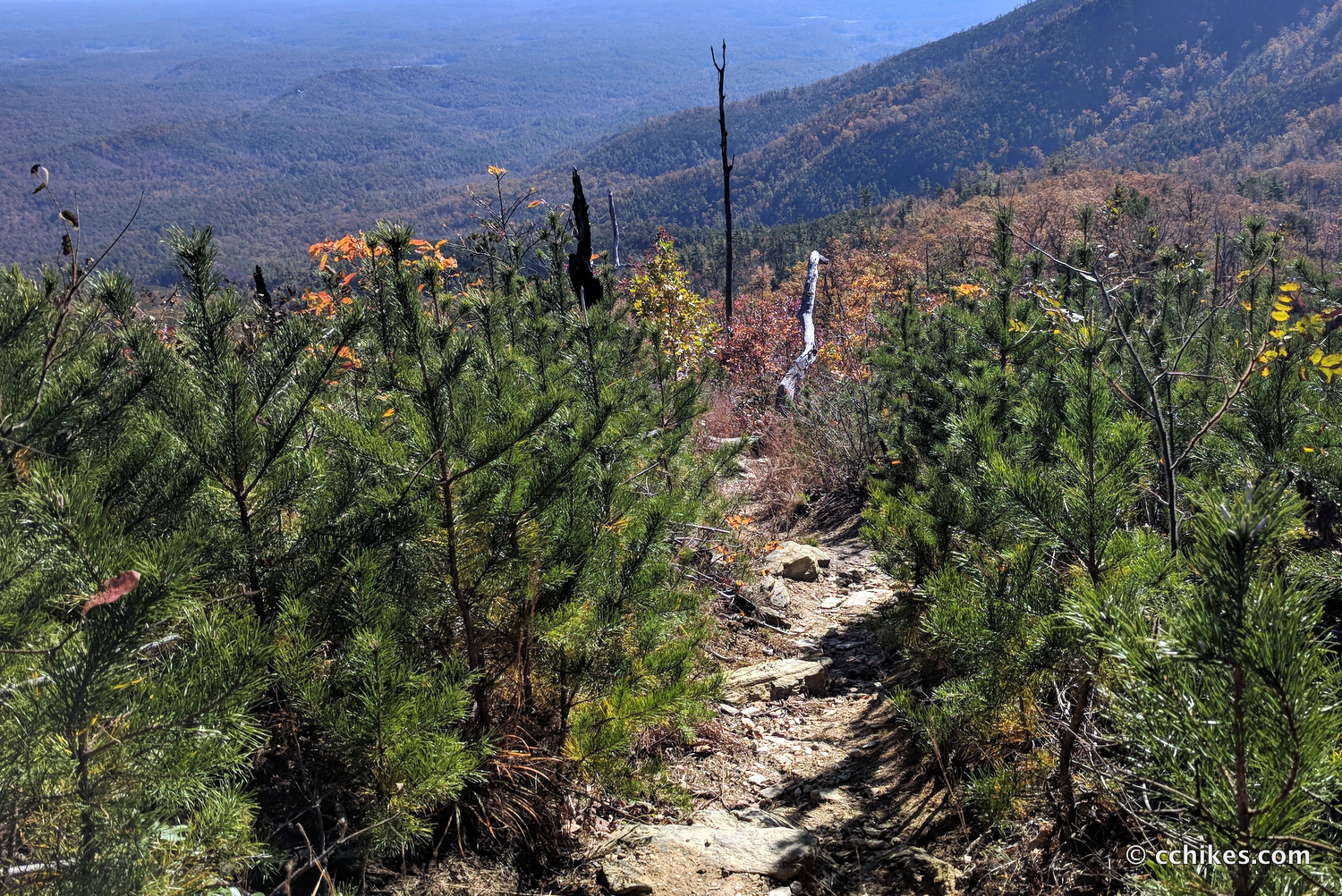
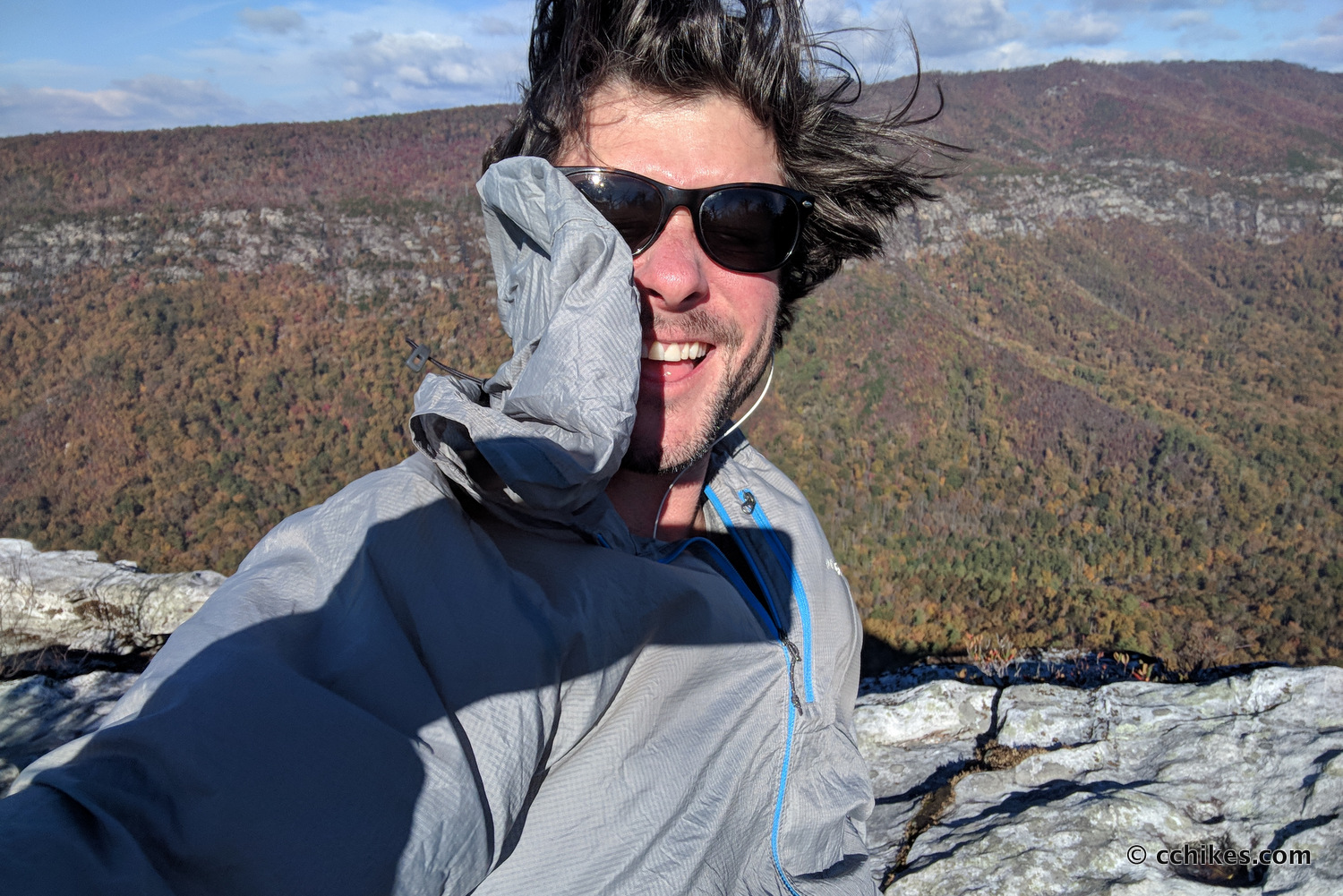

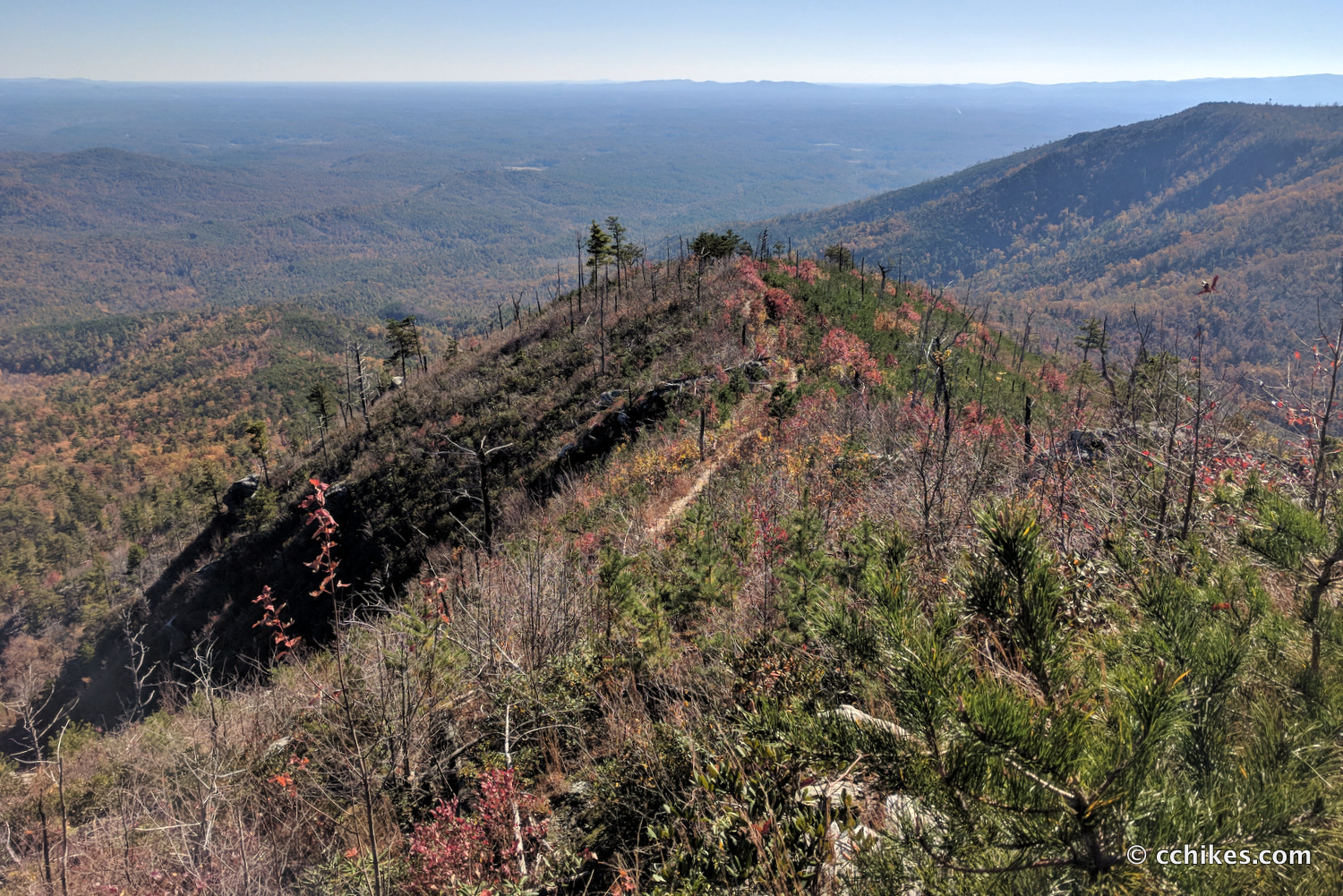
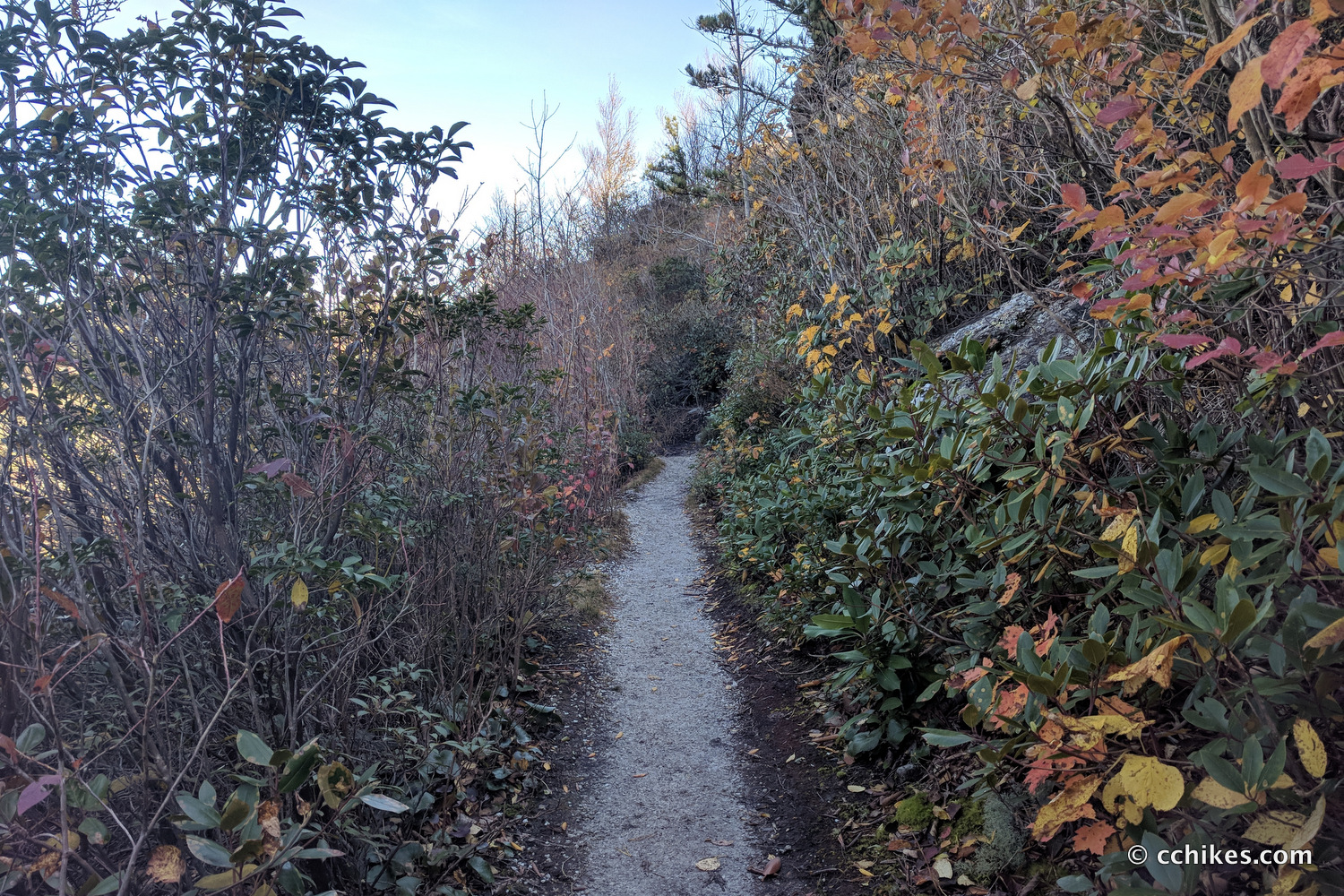
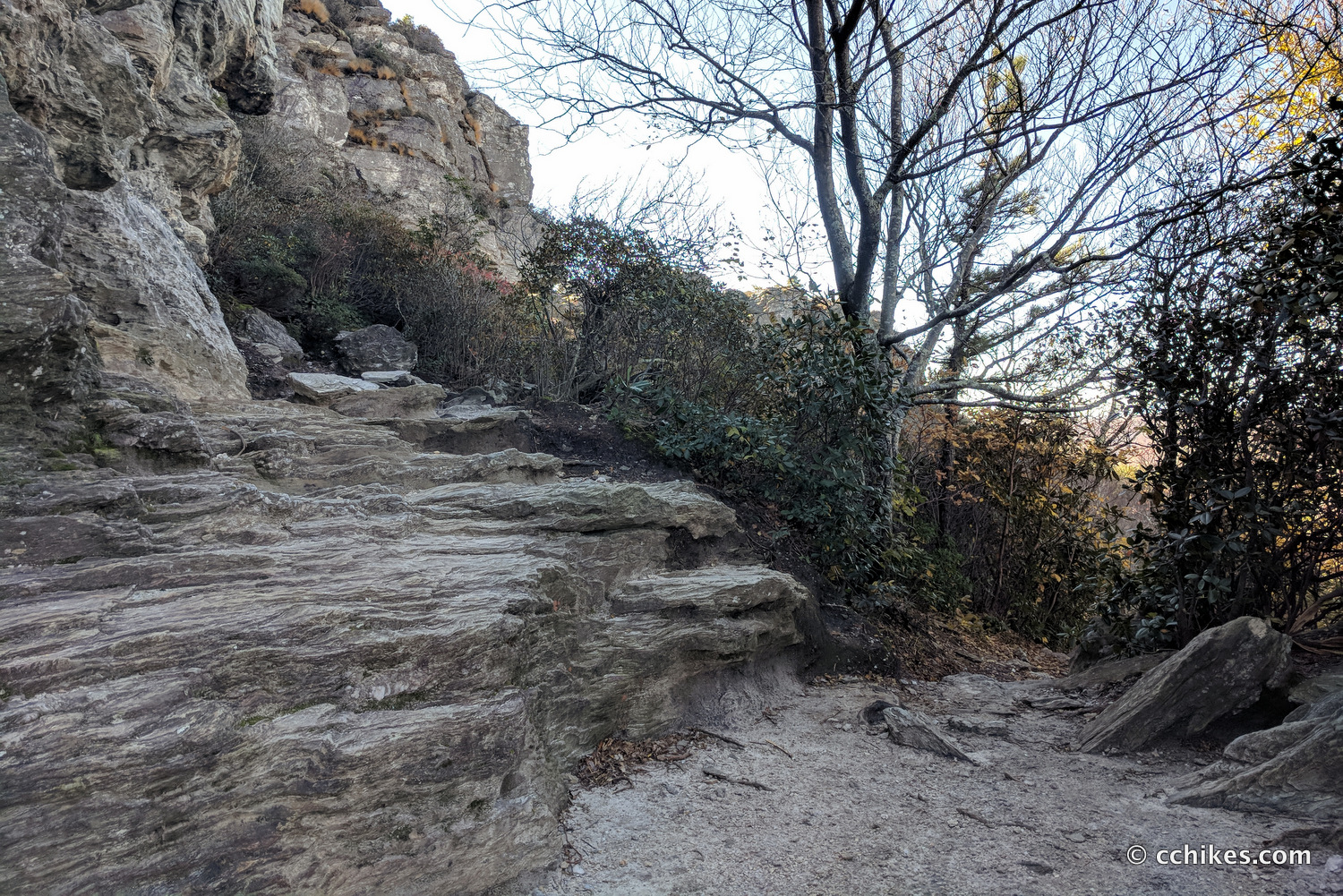



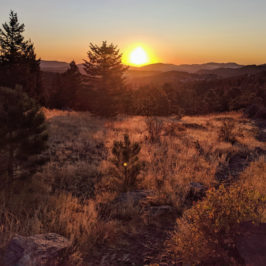
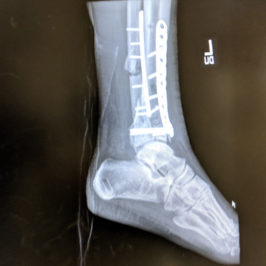

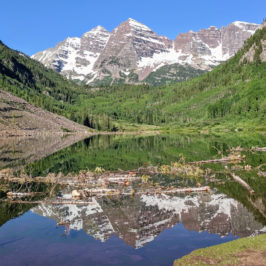
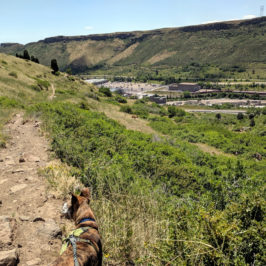

Erin
Really awesome that you were able to maintain such a positive attitude about the experience. I broke my arm backpacking solo and I was very lucky to be able to walk to the road to get a ride. Initially I really struggled with feeling bad about myself and like a failure. Most people are very critical of my decision to backpack solo, especially as a woman, and after I broke my arm many people told me I should never backpack again because it’s too dangerous. They very much had an “I told you so” attitude. Well, I did get over it and I still backpack alone all the time. Hope your leg is healing well and you can get out there again soon!
Chad Chandler
Thanks for your kind words, Erin! I’m glad to hear you’re still out there doing what makes you happy.
Kerry de la Vega
I’ve been hiking in and around the Gorge for 40 plus years. It is by far my favorite place in all of NC. I’ve taken my son there many times, and now he is taking his friends there. What you experienced there was beyond what anybody should ever have to experience. Your harrowing experience could easily be a movie of the week on TV. In all of my visits to the Gorge the worst thing I’ve experienced is leg cramps, which completely pales in comparison to what happened to you. I pray you make a full and complete recovery.
David
Bro just reading this now. Saw #2 as well. Man what an ordeal. I feel your pain though. Last year I went through two hip reconstructions at 51 years old (FAI) repair not replacements so much more pain and recovery and thought hey im maxed on health care so lets get that pesky gallbladder out as well. Wow what a pain fest year that was. Just crushed 40 miles on the road bike today. There were so many times when I truly believed that would never again be possible and here I am planning a backpacking trip from your site. Been through two major shoulder surgeries as well. The human body is an amazing machine. You can do anything you set your mind to, attitude is key and relentless motivation and work to get back to the things you love. I can clearly remember barely getting around on crutches carrying a old grocery bag around the house hanging off my crutch handle with my crap in it. All the best to you man!